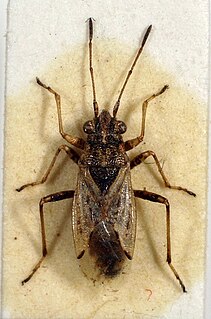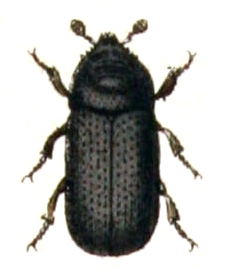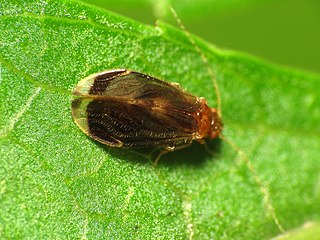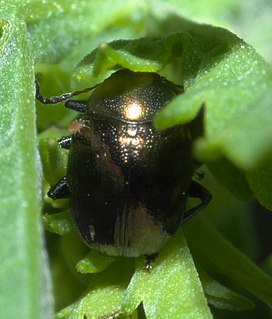
The Integrated Taxonomic Information System (ITIS) is an American partnership of federal agencies designed to provide consistent and reliable information on the taxonomy of biological species. ITIS was originally formed in 1996 as an interagency group within the US federal government, involving several US federal agencies, and has now become an international body, with Canadian and Mexican government agencies participating. The database draws from a large community of taxonomic experts. Primary content staff are housed at the Smithsonian National Museum of Natural History and IT services are provided by a US Geological Survey facility in Denver. The primary focus of ITIS is North American species, but many biological groups exist worldwide and ITIS collaborates with other agencies to increase its global coverage.

Nysius is a genus of false chinch bugs in the family Lygaeidae. At least 100 described species are placed in Nysius.

Cryphalus is a genus of typical bark beetles in the family Curculionidae. There are at least 5 described species in Cryphalus. The Catalogue of Life lists more than 290 provisionally accepted species, although these may be primarily synonyms of other species.

Amphipsocidae is a family of hairy-winged barklice in the order Psocodea. Most species are 3.0-4.5 mm long and have many setae (hairs) on the veins and margin of the forewing. The main veins of the forewing are usually lined with two rows of setae. Like the other members of the infra-order Caeciliusetae, they have a broad, flat labrum, with well defined edges.
The Catalogue of Life is an online database that provides an index of known species of animals, plants, fungi, and microorganisms. It was created in 2001 as a partnership between the global Species 2000 and the American Integrated Taxonomic Information System. The Catalogue interface is available in twelve languages and is used by research scientists, citizen scientists, educators, and policy makers. The Catalogue is also used by the Biodiversity Heritage Library, the Barcode of Life Data System, Encyclopedia of Life, and the Global Biodiversity Information Facility. The Catalogue currently compiles data from 168 peer-reviewed taxonomic databases that are maintained by specialist institutions around the world. As of June 2021, the Catalogue lists 1,997,284 of the world's 2.2m extant species known to taxonomists on the planet at present time.
Gnadochaeta is a genus of bristle flies in the family Tachinidae. There are at least 30 described species in Gnadochaeta.

Campiglossa is a genus of fruit flies in the family Tephritidae. There are at least 190 described species in Campiglossa.

Thecophora is a genus of thick-headed fly from the family Conopidae.
Homalura is a genus of frit flies in the family Chloropidae. There are about six described species in Homalura.

Cerylonidae are small to tiny, smooth, shiny, hairless beetles, only lightly punctured. There are about 450 species worldwide in 50 or so genera, mostly tropical and subtropical. They are most common under the bark of dead trees, but can also occur in compost and other decaying plant material. Little is known specifically about their biology but they are thought to be either predators that feed on other small animals or fungus eating.

Margarinotus is a genus of clown beetles in the family Histeridae. There are at least 110 described species in Margarinotus.

Macrodactylus known as rose chafers are a genus in the family Scarabaeidae. There are at least 110 described species in Macrodactylus.

Ptenothrix is a genus of globular springtails in the family Dicyrtomidae. There are about 11 described species in Ptenothrix.

Brachypnoea is a genus of leaf beetles in the subfamily Eumolpinae. It is mostly found in the Neotropical realm, though there are also eight known species in the Nearctic realm.

Lucidota atra, the black firefly, is a species of firefly in the beetle family Lampyridae. It is found in Central America and North America. Fireflies females lay eggs in moist soils, for some aquatic species, eggs are laid in the ponds. Firefly in larvae stage haunt for snails, slugs, and other small insects. This stage lasts 1-2 years. They gain most nutrition and chemicals during that period. The molting occurs constantly as firefly grows. Adult fireflies despite having mouth parts, do not need to feed. However, sometimes they eat but not for nutritional purpose. Fireflies were observed feeding on milkweed both in adult and larvae stages. It could show that consumption of milkweed makes a good deterrent for predators, however more research is needed for fireflies.
Mallophora atra, the black bee killer, is a species of robber flies in the family Asilidae.
Zeugophora atra is a species of megalopodid leaf beetle in the family Megalopodidae. It is found in North America.

Wohlfahrtia is a genus of flesh flies in the family Sarcophagidae. There are at least 20 described species in Wohlfahrtia.

Argia tibialis, the blue-tipped dancer, is a species of narrow-winged damselfly in the family Coenagrionidae. It is found in Central America and North America.
Gymnusa atra is a species of rove beetle in the family Staphylinidae. It is found in Europe and Northern Asia and North America.














